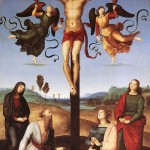Morgan, David. Visual Piety: A history and theory of popular religious images University of California Press, 1998
Since I started this project, I’ve thought that Christian religious art depicting Christ and saints in positions of torment was a key element in the story. But I’ve yet to find a good book on the subject that explains the why of these images.
Morgan’s book is a good start on this. He links the late medieval practice of depicting a beaten, bloody Christ to the psychological practice of empathy. In this case, the believer practices piety by looking at the image of Christ (or a saint) and imagining him or her self in the same situation. Humanity suffers along with Christ, and reaches the divine. The suffering body is a route to the divine, or put another way, we suffer to reach beyond ourselves. God suffers as humans do.
Later on, religious art develops into a different but related practice of piety called sympathy. The sympathetic viewer doesn’t imagine him or herself as the person suffering, but views them from a distance, experiencing suffering of a lower person (slave, woman, child, savage). This relationship of suffering inferior and sympathetic observing superior replicates the relationship of humanity and Christ. Just as Christ is so vastly superior to the abject inferior, the Christian (usually male) observor is vastly superior and merciful (in a condescending and patronizing way) to the suffering, subordinate other. It can even be felt by the person who makes the subordinate suffer. E.g. the way Lovelace imprisons and torments the heroine in the novel Clarissa.
It’s entirely possible for those two perspectives to be felt towards the same image, as shown in the ambivalent reactions to abolitionist art. It’s even possible for those two perspectives to be experienced simultaneously in the same person.
Masochism can be viewed as empathetic. E.g. Severin wants to get as low and possible and become “the martyr of a woman” in Venus In Furs, whereas sadism is sympathetic, E.g. Sade sets himself up as he imagines God to be, an arbitrary force of nature that brings about suffering, beyond any human idea of morality.
A top and a bottom could be seen as a pairing of a sympath (who wants to see suffering) with an empath (who wants to suffer.) But does that really work? I’m still not certain if that’s how the dom/sub-top/bottom relationship started. Need to think about this.
Perhaps this is better applied to BDSM imagery rather than BDSM practice. I think a heterosexual male viewer of, say, House of Gord-type bondage photos and videos may not necessarily only identify with the top in such scenarios (or imagine himself into the scenario), viewing the bound woman sympathetically. He may also view the bound woman empathetically, feeling what (he imagines) she feels.
Carol J Clover, in her book Men, Women and Chainsaws: Gender in the Modern Horror Film, develops a theory about the relationship between the adolescent male viewer of slasher film and the dyad between the killer and the Final Girl. Applying this theory to BDSM fantasy, the het male viewer vicariously experiences vulnerability and desirability through the figure of the female sub/bottom.
I think that fits. There seems to be a lot of BDSM porn stories written from the sub female’s POV. A female submissive figure can be related to in both ways, sympathetically and empathetically, to a heterosexual male viewer. A male submissive figure is a different matter. It’s more difficult to relate sympathetically for a male viewer, leaving only empathy, and diminishing audience appeal.



